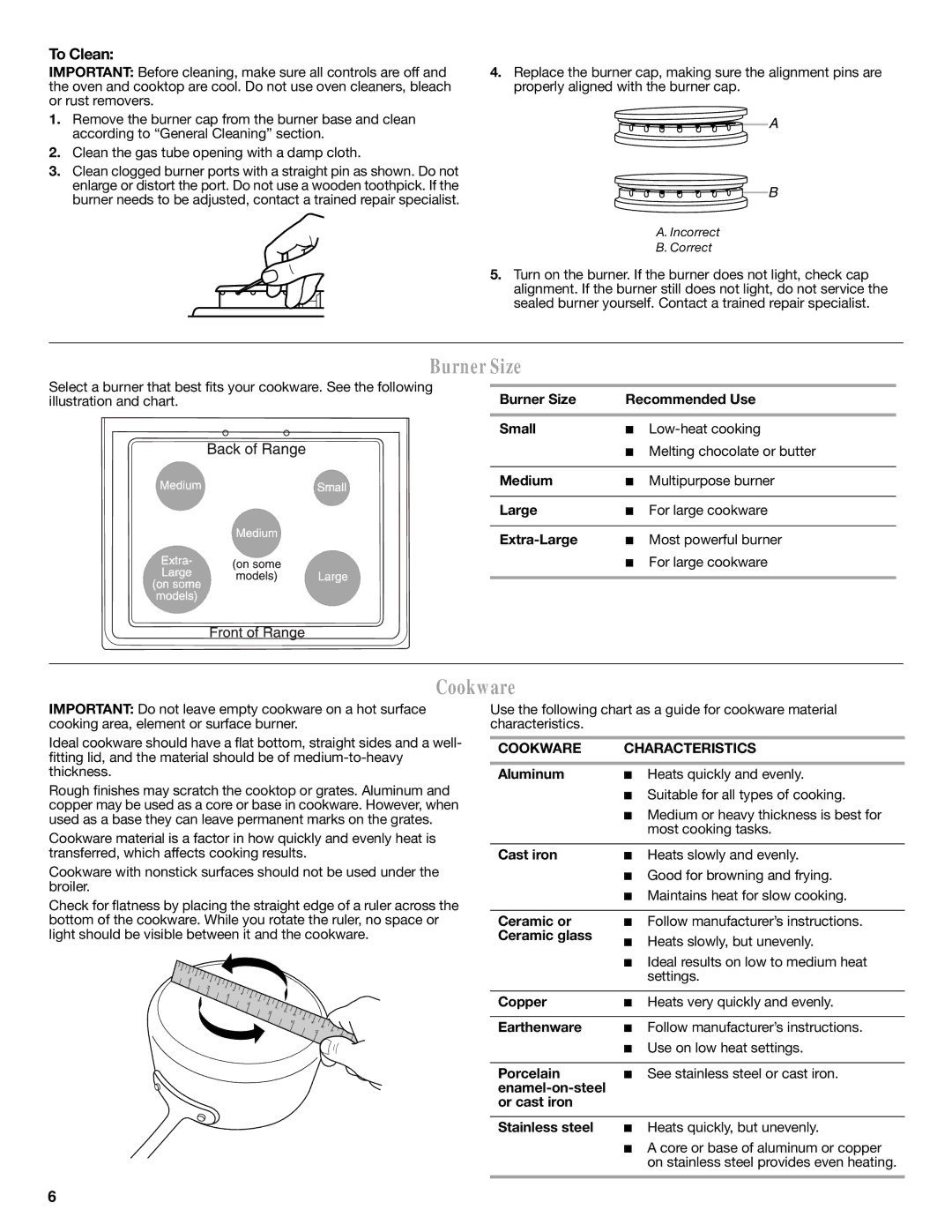
To Clean:
IMPORTANT: Before cleaning, make sure all controls are off and the oven and cooktop are cool. Do not use oven cleaners, bleach or rust removers.
1.Remove the burner cap from the burner base and clean according to “General Cleaning” section.
2.Clean the gas tube opening with a damp cloth.
3.Clean clogged burner ports with a straight pin as shown. Do not enlarge or distort the port. Do not use a wooden toothpick. If the burner needs to be adjusted, contact a trained repair specialist.
4.Replace the burner cap, making sure the alignment pins are properly aligned with the burner cap.
A
B
A.Incorrect
B.Correct
5.Turn on the burner. If the burner does not light, check cap alignment. If the burner still does not light, do not service the sealed burner yourself. Contact a trained repair specialist.
BurnerSize
Select a burner that best fits your cookware. See the following illustration and chart.
Burner Size | Recommended Use | |
|
|
|
Small | ■ | |
| ■ Melting chocolate or butter | |
|
|
|
Medium | ■ | Multipurpose burner |
|
|
|
Large | ■ | For large cookware |
|
|
|
■ | Most powerful burner | |
| ■ | For large cookware |
|
|
|
Cookware
IMPORTANT: Do not leave empty cookware on a hot surface cooking area, element or surface burner.
Ideal cookware should have a flat bottom, straight sides and a well- fitting lid, and the material should be of
Rough finishes may scratch the cooktop or grates. Aluminum and copper may be used as a core or base in cookware. However, when used as a base they can leave permanent marks on the grates.
Cookware material is a factor in how quickly and evenly heat is transferred, which affects cooking results.
Cookware with nonstick surfaces should not be used under the broiler.
Check for flatness by placing the straight edge of a ruler across the bottom of the cookware. While you rotate the ruler, no space or light should be visible between it and the cookware.
1 2
| 3 |
|
1 | 4 |
|
| 5 | |
| 2 | 6 |
| 7 |
| 8 |
3 | 9 |
1 0 |
4 | 1 1 |
|
|
|
1 2 | 1 3 |
|
| |
|
|
|
| |
| 5 | 1 | 4 |
|
|
|
| 1 5 |
|
|
|
| 1 | 6 |
|
|
| 6 | 1 7 |
| 1 8 |
|
7 | 1 | 9 |
| ||
|
| 2 0 |
Use the following chart as a guide for cookware material characteristics.
COOKWARE | CHARACTERISTICS | |
|
| |
Aluminum | ■ Heats quickly and evenly. | |
| ■ Suitable for all types of cooking. | |
| ■ Medium or heavy thickness is best for | |
|
| most cooking tasks. |
|
| |
Cast iron | ■ Heats slowly and evenly. | |
| ■ Good for browning and frying. | |
| ■ Maintains heat for slow cooking. | |
|
|
|
Ceramic or | ■ | Follow manufacturer’s instructions. |
Ceramic glass | ■ Heats slowly, but unevenly. | |
| ||
| ■ Ideal results on low to medium heat | |
|
| settings. |
|
| |
Copper | ■ Heats very quickly and evenly. | |
|
|
|
Earthenware | ■ | Follow manufacturer’s instructions. |
| ■ Use on low heat settings. | |
|
| |
Porcelain | ■ See stainless steel or cast iron. | |
|
|
|
or cast iron |
|
|
|
| |
Stainless steel | ■ Heats quickly, but unevenly. | |
| ■ A core or base of aluminum or copper | |
on stainless steel provides even heating.
6
